Walter Burley Griffin
| Walter Burley Griffin | |
|---|---|
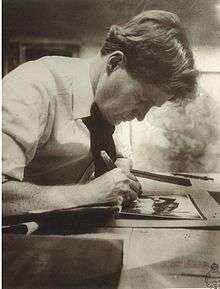 Walter Burley Griffin in 1912 | |
| Born |
24 November 1876 Maywood, Chicago, Illinois |
| Died | February 11, 1937 (aged 60) |
| Nationality | American |
| Alma mater | University of Illinois |
| Occupation | Landscape architect |
| Years active | 1890s–1930s |
| Known for | Prairie School |
| Notable work | Design/plan of Canberra, Australia |
| Spouse(s) | Marion Mahony Griffin (m. 1911) |
Walter Burley Griffin (November 24, 1876 – February 11, 1937) was an American architect and landscape architect. He is known for designing Canberra, Australia's capital city. He has been credited with the development of the L-shaped floor plan, the carport and an innovative use of reinforced concrete.
Influenced by the Chicago-based Prairie School, Griffin developed a unique modern style. He worked in partnership with his wife Marion Mahony Griffin. In 28 years they designed over 350 buildings, landscape and urban-design projects as well as designing construction materials, interiors, furniture and other household items.
Early life
Griffin was born in 1876 in Maywood, Illinois, a suburb of Chicago. He was the eldest of the four children of George Walter Griffin, an insurance agent, and Estelle Burley Griffin. His family moved to Oak Park and later to Elmhurst. As a boy he had an interest in landscape design and gardening, and his parents allowed him to landscape the yard at their new home in Elmhurst. Griffin went to Oak Park High School. He considered studying landscape design but was advised by the landscape gardener O. C. Simonds to pursue a more lucrative profession.
Griffin chose to study architecture, and, in 1899, completed his bachelor's degree in architecture at the University of Illinois. The University of Illinois program was run by Nathan Clifford Ricker, a German-educated architect, who emphasized the technical aspects of architecture. During his studies, he also took courses in horticulture and forestry.
Chicago career
After his studies, Griffin moved to Chicago and was employed as a draftsman for two years in the offices of progressive architects Dwight H. Perkins, Robert C. Spencer, Jr., and H. Webster Tomlinson in "Steinway Hall". Griffin's employers worked in the distinctive Prairie School style. This style is marked by horizontal lines, flat roofs with broad overhanging eaves, solid construction, craftsmanship, and strict discipline in the use of ornament. Louis Sullivan was influential among Prairie School architects and Griffin was an admirer of his work, and of his philosophy of architecture which stressed that design should be free of historical precedent. Other architects of that school include George Grant Elmslie, George Washington Maher, William Gray Purcell, William Drummond and most importantly, Frank Lloyd Wright.
In July 1901 Griffin passed the new Illinois architects' licensing examination and this permitted him to enter private practice as an architect. He began to work in Frank Lloyd Wright's famous Oak Park, Illinois, studios. Although he was never made a partner, Griffin oversaw the construction on many of Wright's noted houses including the Willits House in 1902 and the Larkin Administration Building built in 1904. From 1905 he also began to supply landscape plans for Wright's buildings. Wright allowed Griffin and his other staff to undertake small commissions of their own. The William Emery house, built in Elmhurst, Illinois, in 1903 was such a commission. While working for Wright, Griffin fell in love with Mr. Wright's sister, Maginel Wright. He proposed marriage to her, but his affections for her were not returned, and she refused.
In 1906 he resigned his position at Wright's studio and established his own practice at Steinway Hall. Griffin and Wright had fallen out over events following Mr. Wright's trip to Japan in 1905. While Wright was away for five months, Griffin ran the practice. When Wright returned, he told Griffin that he had overstepped his responsibilities, completing several of Wright's jobs, and sometimes substituting his own building designs. Further, Wright had borrowed money from Griffin to pay for his travels abroad, and then he tried to pay off his debts to Griffin with prints he had gotten in Japan. It became clear to Griffin then that Wright would not make Griffin a partner in his business.
Griffin's first independent commission was a landscape design for the State Normal School at Charleston, Illinois, now known as the Eastern Illinois University. In the fall of 1906, he received his first residential job from Harry Peters. The Peters' House was the first house designed with an L-shaped or open floor plan. The L-shape was an economical design and easily constructed. From 1907, 13 houses in this style were built in the Chicago neighborhood now known as Beverly-Morgan Park. Seven of these houses are on W. 104th Place in Beverly, Chicago. This street is now named Walter Burley Griffin Place, and forms a municipal historical district within the national Ridge Historic District, as it contains the largest collection of small scale Griffin designs.

In 1911 Griffin married Marion Lucy Mahony, a graduate of the Massachusetts Institute of Technology in architecture. She was employed first in Wright's office, and then by Hermann V. von Holst, who had taken over Wright's work in America when Wright left for Europe in 1909. Marion Mahony recommended to von Holst that he hire Griffin to develop a landscape plan for the area surrounding the three houses on Milliken Place for which Wright had been hired in Decatur, Illinois. Mahony and Griffin worked closely on the Decatur project immediately before their marriage. After their marriage, Mahony went to work in Griffin's practice.[1] A Walter Burley Griffin and Marion Mahony-designed development with several homes, Rock Crest Rock Glen in Mason City, Iowa, is seen as their most dramatic American design development of the decade and remains the largest collection of Prairie Style homes surrounding a natural setting.[2]
From 1899 to 1914, Griffin created more than 130 designs in his Chicago office for buildings, urban plans and landscapes; half of these were built in mid-western states of Illinois, Iowa, Michigan and Wisconsin. In 1981, the city of Chicago granted landmark status to the Prairie-style bungalows designed between 1909 and 1914 by Griffin in the 1700 block of West 104th Place (also known as the Griffin Place Historic District), as well as 12 blocks on Longwood Drive and three blocks along Seeley Avenue between 98th and 110th Streets.
The relationship between Griffin and Frank Lloyd Wright cooled in the years following Griffin's departure from Wright's firm in 1906. With Walter and Marion's wedding, Wright started to feel they were "against him". After the Griffins' win in the Canberra design competition, and resultant front page coverage in the New York Times, Wright and Griffin never spoke to each other again. In later years, whenever Griffin was brought up in conversation Wright would downplay his achievements and refer to him as a draftsman.[3]
- William H. Emery, Jr. House, 1903
 Frederick Carter House 1910
Frederick Carter House 1910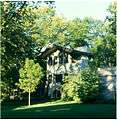 Page House, 1912
Page House, 1912 Blythe-Rule House, 1913
Blythe-Rule House, 1913 Ralph Griffin House, 1913
Ralph Griffin House, 1913 Melson House, 1914
Melson House, 1914 Blythe House, 1914
Blythe House, 1914
Canberra
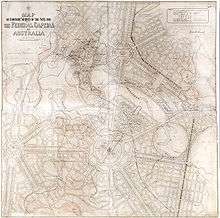
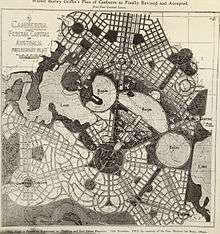
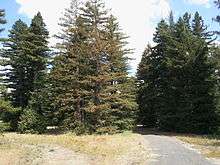
In April 1911 the Australian Government held an international competition to produce a design for Canberra, its new capital city. Griffin produced a design with impressive renderings of the plan produced by his wife. They first heard about the competition in July, while on honeymoon, and worked feverishly to prepare the plans. On May 23, 1912, Griffin's design was selected as the winner from among 137 entries. This created significant press coverage at the time and brought him professional and public recognition. Of his plan, he famously remarked:
"I have planned a city that is not like any other in the world. I have planned it not in a way that I expected any government authorities in the world would accept. I have planned an ideal city – a city that meets my ideal of the city of the future."
In 1913 he was invited to Australia to inspect the site. He left Marion in charge of the practice and travelled to Australia in July. His letters reveal his appreciation for the Australian landscape. Griffin and his wife Marion joined the Naturalists’ Society of New South Wales in 1914, where they enjoyed organised bush walks and field studies. The Society facilitated their contact with the Australian scientific community, especially botanists. This appreciation for Australia flora was reflected in Griffin's 1914 town plan for Leeton in the Murrumbidgee Irrigation Area, and later in a design for Newman College at the University of Melbourne.[4] He also utilised Australian flora botanical names as places names for suburbs and streets in Canberra, such as Grevillea Park, Telopea Park, Clienthus Circle and Blandfordia.[5]
Griffin was offered the position of head of the department of architecture at the University of Illinois. At the same time he was negotiating a three-year contract with the Australian Government to remain in Australia and oversee the implementation of his plan, which he felt had already been compromised. He was appointed the Federal Capital Director of Design and Construction. In this role, Griffin oversaw the design of North and South Canberra, though he struggled with political and bureaucratic obstacles. With the outbreak of World War I in 1914, Griffin was under pressure to reduce the scope and scale of his plans due to the Government diverting funds towards the war effort. Several parts of his basic design underwent change. Plans to create Westbourne, Southbourne and Eastbourne Avenues to complement Canberra's Northbourne Avenue were eliminated, as did a proposed railway connecting South Canberra to North Canberra, and then in a northwesterly direction to Yass. A market area that would have been at Russell Hill in North Canberra was moved south to what is now Fyshwick, next to South Canberra.
The pace of building was slower than expected, partly because of a lack of funds and partly because of a dispute between Griffin and Federal government bureaucrats. Many of Griffin's design ideas were attacked by both the architectural profession and the press. In 1917 a Royal Commission determined that they had undermined Griffin's authority by supplying him with false data which he had used to carry out his work. Ultimately, Griffin resigned from the Canberra design project in December 1920 when he discovered that several of these bureaucrats had been appointed to an agency that would oversee Canberra's construction. The Commonwealth Government under the leadership of Prime Minister Hughes had removed Griffin as director of construction at Canberra after disagreements over his supervisory role, and in 1921 created the Federal Capital Advisory Committee, with John Sulman as chair. Griffin was offered membership, but declined and withdrew from further activity in Canberra.[6]
Griffin designed several buildings for Canberra, none of which were built. The grave of General Bridges on Mount Pleasant was the only permanent structure designed by Griffin to be built in Canberra.
Aside from the city's design, his longest-living legacy is the forest of Redwood trees (both Sequoia sempervirens and Sequoiadendron giganteum) planted in 1918 by Walter Burley Griffin and arborist Thomas Charles Weston on Pialligo, ACT on Pialligo Avenue between Canberra and Queanbeyan.
Later career

The Griffins' office in Chicago closed in 1917; however, they had successful practices in Melbourne and Sydney, which were a strong motivation for their continuing to live in Australia. The Griffins had received commissions for work outside Canberra since Walter first arrived in the country in 1913, designing town plans, subdivisions, and one of his highly regarded buildings, Newman College, the Catholic residential college of the University of Melbourne while employed in Canberra. While supervising activities in Canberra, Griffin spent much time in Melbourne and, in 1918, became a founder, with Royden Powell, of the Henry George Club, an organisation devoted to providing a home for the Single Tax movement.[7] The Griffins' first major commission after leaving Canberra was the Capitol Theatre in Melbourne; it opened on November 7, 1924. In 1964 architectural writer Robin Boyd described the Capitol as "the best cinema that was ever built or is ever likely to be built".
In 1916 and 1917 Griffin developed a patented modular concrete construction system known as "Knitlock" for use in the construction of Canberra. No Knitlock buildings were ever built in Canberra, although several were built in Australia. The first were built on Griffin's property in Frankston in 1922, where he constructed two holiday houses called "Gumnuts". The best examples of Knitlock include the S.R. Salter House in Toorak and the Paling House. Frank Lloyd Wright designed a similar system and used Griffin's design to support the arguments for his design.
In 1919 the Griffins founded the Greater Sydney Development Association (GSDA), and in 1921 purchased 259 ha of land in North Sydney. The GSDA's goal was the development of an idyllic community with a consistent architectural feel and bushland setting. Walter Burley Griffin as managing director of the GSDA designed all the buildings built in the area until 1935. Castlecrag was the first suburb to be developed by the GSDA. The Redding House and several others in Castelcrag were also built in Knitlock. Almost all the houses Griffin designed in Castlecrag were small and had flat roofs, and he included an internal courtyard in many of them. Griffin used what was at that time the novel concept of including native bushland in these designs. He came to be referred to as "The Wizard of Castlecrag".
Other work the Griffins did during this time included the Melbourne subdivisions of Glenard and Mount Eagle at Eaglemont. Prior to 1920 the Griffins also designed the New South Wales towns of Leeton and Griffith. Griffin and architect J Burcham Clamp designed a large tomb built at Waverley Cemetery, Sydney, between 1914 and 1916 for James Stuart, which still stands as a good example of Griffin's sense of 'human-scale monumentality'.[8]

The Griffins participated in the celebrated Chicago Tribune Tower Competition in 1922. Having won one famous international competition, as architects who were both well acquainted with Chicago and recognized as practical visionaries, they offered a solution that was positive, forward-looking and elegant. Indeed, their entry appears to be about a decade ahead of its time, with emphatic verticality along the lines of the Art Deco or Art Moderne. It anticipated and would have been a near neighbor of Chicago's 333 North Michigan by Holabird & Roche (1928); with stylistic echos in John and Donald Parkinson's Bullocks Wilshire, in Los Angeles (1929), as well as Adah Robinson and Bruce Goff's Boston Avenue Methodist Church, Tulsa (1929).[9]
In the 1920s they prepared plans for the Milleara Estate (also known as City View) at Avondale Heights, and the Ranelagh Estate at Mount Eliza, in conjunction with surveyors Tuxen and Miller. During the financial hardship of the Depression in the 1930s Griffin was commissioned to design incinerators; Willoughby Incinerator in the Sydney suburb of Willoughby is a good example of this work and was only one of twelve designed between 1930 and 1938. It has been listed by the National Trust and the Royal Australian Institute of Architects as a building of significance. In 1999 it was listed in the New South Wales State Heritage Register.[10] The Walter Burley Griffin Incinerator in Ipswich, Queensland is listed on the Queensland Heritage Register and has been converted into a theatre.[11] Another incinerator was built in the suburb of Pyrmont, not far from the centre of Sydney. This incinerator was considered for heritage listing but was demolished in 1992 because it was in irredeemably bad condition.[12] Another two surviving incinerators are also located in the Adelaide suburbs of Hindmarsh Incinerator and Thebarton.
India
During their time at the GSDA, the Griffins became more involved in anthroposophy,[13] and in 1935 through contacts in the movement Griffin won a commission to design the library at the University of Lucknow in Lucknow, India.
Although he had planned to stay in India only to complete the drawings for the library, he soon received more than 40 commissions, including the University of Lucknow Student Union building; a museum and library for the Raja of Mahmudabad; a zenana (women's quarters) for the Raja of Jahangirabad; Pioneer Press building, a bank, municipal offices, many private houses, and a memorial to King George V. He also won complete design responsibility for the 1936–1937 United Provinces Exhibition of Industry and Agriculture. His 53 projects for the 160-acre (0.65 km2) site featured a stadium, arena, mosque, imambara, art gallery, restaurant, bazaar, pavilions, rotundas, arcades, and towers,[14][15] however, only part of his elaborate plans were fully executed.[16] Griffin was inspired by the architecture and culture of India, modifying forms as "he sought to create a modern Indian architecture... Griffin was able to expand his aesthetic vocabulary to create an exuberant, expressive architecture reflecting both the 'stamp of the place' and the 'spirit of the times'".[17] While in India, Griffin also published numerous articles for the Pioneer, writing about architecture, in particular about ventilation design improvements. His wife Marion traveled to Lucknow in April 1936 to assist and contributed to several projects.
Death and Burial in India
Griffin died of peritonitis in early 1937, five days after gall bladder surgery at King George's Hospital, Lucknow in Lucknow city in state of Uttar Pradesh, India, and was buried in Christian Cemetery in Lucknow. Marion Mahony Griffin oversaw the completion of the Pioneer Building that he had been working on at the time of his death. She closed down their Indian offices, then left their Australian practice in the hands of Griffin's partner, Eric Milton Nicholls, and returned to Chicago.[15]
Legacy
Griffin was largely under-appreciated during his time in Australia, but since his death there has been a growing recognition of his work. In 1964 when Canberra finally got its central lake (as Griffin had intended), Prime Minister Robert Menzies declined to have the lake named after himself, and he instead named it Lake Burley Griffin, and this became the first monument in Canberra dedicated to the city's designer ("Burley" was included in the name because of the misconception that it was part of the Griffin's surname). Architectural drawings and other archival materials by and about the Griffins are held by numerous institutions in the United States, including the Drawings and Archives Department of Avery Architectural and Fine Arts Library at Columbia University; the Block Gallery at Northwestern University; the Ryerson & Burnham Libraries at the Art Institute of Chicago; and the New York Historical Society, as well as in several repositories in Australia, including the National Library of Australia, National Archives of Australia, and the Newman College Archives of the University of Melbourne. At the centenary of the Griffins' design work for Canberra, some believe they are owed a permanent memorial.[18]
In his own words
...."I am what may be termed a naturalist in architecture. I do not believe in any school of architecture. I believe in architecture that is the logical outgrowth of the environment in which the building in mind is to be located".... From The New York Times, Sunday, June 2, 1912[19]
Major works
India
- Library in University of Lucknow, in Lucknow city in the state of Uttar Pradesh in India
- Dr Bhatia's Residence, is still extant in Lucknow city in the state of Uttar Pradesh in India
United States
- G.B. Cooley House,1908 South Grand St., Monroe, Louisiana
- Alfred W. Hebert House Remodeling, 1902, Evanston, Illinois
- W.H. Emery House, 1903, Elmhurst, Illinois
- Adolph Mueller House, 1906
- Mary H. Bovee Apartment, 1907
- John Gauler House, 1908, Chicago, Illinois
- William S. Orth House, 1908, Winnetka, Illinois
- Edmund C. Garrity House, 1909
- Ralph Griffin House, 1909, Edwardsville, Illinois
- Edmund C. Garrity House, 1712 W. 104th Place, Chicago, Illinois, 1909
- William B. Sloan House, 1910
- Harry N. Tolles House, 10561 S. Longwood Drive, Chicago, Illinois, 1911
- Harry G. Van Nostrand House, 1666 W. Griffin PIace, Chicago, Illinois, 1911
- Russell L. Blount House I, 1724 W. Griffin Place, Chicago, Illinois, 1911
- Benjamin J. and Mabel T. Ricker House, Grinnell, Iowa, 1911-1912
- Joshua Melson House, 1912, Mason City, Iowa
- Russel L. Blount House II, 1950 W. 102nd Street, Chicago, Illinois, 1912–1913
- Jenkinson House, 1727 W. Griffin Place, Chicago, Illinois, 1912–1913
- Walter D. Salmon House, 1736 W. Griffin PIace, Chicago, Illinois, 1912–1913
- Newland house, 1737 W. Griffin Place, Chicago, Illinois, 1913
- Ida E. Williams House, 1632 W. Griffin Place, Chicago, Illinois (based on the Von Nostrand plans, built by Blount), 1913
- William R. Hornbaker House, 1710 W. Griffin Place, Chicago, Illinois, (based on the Von Nostrand plans, built by Blount), 1914
- James Frederic Clarke House, 1731 W. Griffin Place, Chicago, Illinois, (based on the Von Nostrand plans, built by Blount), 1913
- Harry C. Furneaux House, 1741 W. Griffin Place, Chicago, Illinois, (based on the Salmon House plans, built by Blount), 1913
- James Blyth House, Mason City, Iowa
- Stinson Memorial Library, Anna, Illinois
Australia
- Canberra plan, 1914–1920
- Leeton town plan, 1914
- Griffith town plan, 1914
- Eaglemont town plan, 1915
- Newman College, University of Melbourne, 1916–1918
- Café Australia, Melbourne, 1916
- Capitol Theatre, Melbourne 1924
- Palais de danse, St Kilda 1925 (destroyed by fire)
- Leonard House, Elizabeth Street Melbourne 1925 (demolished)
- Castlecrag, suburb plan, 1925
- Castle Cove, suburb plan, 1930
- Paris Theatre, Sydney, 1915 (demolished)
- Hindmarsh Incinerator, South Australia, completed 1936[20]
- Pyrmont Incinerator, completed 1936 (demolished)
- Thebarton Incinerator, South Australia, completed 1937[21]
- Willoughby Incinerator, 1932
- Newman College
- Newman College interior of the dining room
- Capitol Theatre
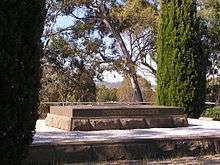 Grave for General Bridges designed by Griffin
Grave for General Bridges designed by Griffin- Hindmarsh Incinerator at Brompton
- Thebarton Incinerator at Thebarton
References
- ↑ Marion Mahony at www.pbs.org
- ↑ Walter Burley Griffin – Mason City at www.pbs.org
- ↑ Paul kruty at www.pbs.org
- ↑ Vernon, C., (2002), ‘Griffin, Walter Burley’, in R. Aitken and M. Looker (eds), Oxford Companion to Australian Gardens, South Melbourne, Oxford University Press, pp. 275–76.
- ↑ Vernon, C., (1997), 'Griffin and Australian flora', Australian Garden History, 8 (5), pp. 10–11.
- ↑ An Ideal City – Timeline at www.idealcity.org.au
- ↑ Henry George Club – Home Page at www.hgclub.com.au
- ↑ "Tomb by Burley Griffin sheds darkness and light", Sydney Morning Herald, July 21, 1998
- ↑ Solomonson, Katherine, "The Chicago Tribune Tower Competition", 2001; page 155
- ↑ Willoughby Council Website
- ↑ "Walter Burley Griffin Incinerator (former) (entry 600596)". Queensland Heritage Register. Queensland Heritage Council. Retrieved 1 August 2014.
- ↑ City of Sydney Website
- ↑ Paull, John (2012) "Walter Burley Griffin and Marion Mahoney Griffin, Architects of Anthroposophy", Journal of Bio-dynamics Tasmania, 106:20-30.
- ↑ National Library of Australia Digital Collections Pictures: nla.pic-vn3674084
- 1 2 Walter Burley Griffin Society, Inc., Walter Burley Griffin
- ↑ Australian Dictionary of Biography, Griffin, Walter Burley (1876–1937)
- ↑ Kruty, Paul & Maldre, Mati, Walter Burley Griffin in America, Urbana: University of Illinois Press, 1996, pp. 76–81
- ↑ Vernon, Christopher 'Let's Not Forget the Griffins', The Canberra Times, Panorama magazine, 17 May 2014 p6, from Australian Design Review, April 2013.
- ↑ NEW YORK TIMES ON GRIFFIN & HIS PLAN at www.library.cornell.edu
- ↑ Building Details - Architects of South Australia > Hindmarsh Incinerator Accessed 13 May 2014.
- ↑ Building Details - Architects of South Australia > Thebarton Incinerator Accessed 13 May 2014.
- Birrell, James. 1964. Walter Burley Griffin. University of Queensland Press
- Gebhard, David & Gerald Mansheim, Buildings of Iowa, Oxford University Press, New York, 1993
- Gebhard, David. “The Suburban House and the Automobile.” The Car and the City: The Automobile, the Built Environment and Daily Urban Life. Ann Arbor: University of Michigan Press, 1991: 106,123.
- Kruty, Paul. 2000. Griffin, Walter Burley. American National Biography Online. Oxford University Press
- MacMahon, Bill (2001). The Architecture of East Australia. Edition Axel Menges. ISBN 3-930698-90-0.
- Mason City Iowa, An Architectural Heritage, Department of Community Development, City of Mason, Iowa, 1977
- Maldre, Mati and Paul Kruty, Walter Burley Griffin in America, University of Illinois Press, Urbana, 1996
- McGregor, Alasdair, 'Grand Obsessions: The life and work of Walter Burley Griffin and Marion Mahony Griffin, Penguin/Lantern, Camberwell, Victoria, 2009
- Walker, M., Kabos, A. and Weirick, J. (1994) Building for nature : Walter Burley Griffin and Castlecrag, Castlecrag, N.S.W. : Walter Burley Griffin Society (ISBN 0-646-18133-5)
- Wilson, Richard Guy and Sidney K. Robinson, The Prairie School in Iowa, Iowa State University Press, Ames, 1977
Further reading
- Brooks, H. Allen, Frank Lloyd Wright and the Prairie School, Braziller (in association with the Cooper-Hewitt Museum), New York 1984; ISBN 0-8076-1084-4
- Brooks, H. Allen, The Prairie School, W.W. Norton, New York 2006; ISBN 0-393-73191-X
- Brooks, H. Allen (editor), Prairie School Architecture: Studies from "The Western Architect", University of Toronto Press, Toronto, Buffalo 1975; ISBN 0-8020-2138-7
- Brooks, H. Allen, The Prairie School: Frank Lloyd Wright and his Midwest Contemporaries, University of Toronto Press, Toronto 1972; ISBN 0-8020-5251-7
- Griffin, Dustin (editor), The Writings of Walter Burley Griffin, Cambridge University Press, Melbourne 2008; ISBN 978-0-521-89713-6
- Townsend, Danielle, ed. (December 2008). "Walter Burley Griffin Lodge". Australian Period Style. Universal Magazines (3): 80–85. ISSN 1441-5259.
- Page, Walter Hines; Page, Arthur Wilson (July 1914). "The March of the Cities: A Young American Architect Building A New Capital For Australia". The World's Work: A History of Our Time. XLIV (2): 351–352. Retrieved 4 August 2009.
- McGregor, Alasdair, 'Grand Obsessions: The life and work of Walter Burley Griffin and Marion Mahony Griffin', Penguin/Lantern, Camberwell, Victoria, 2009 ISBN 978-1-920989-38-5
- Turnbull, J. and Navaretti, P. (eds), The Griffins in Australia and India: the complete works of Walter Burley Griffin and Marion Mahony Griffin, Miegunyah Press, Melbourne 1998; ISBN 0-5228-4830-3
External links
| Wikimedia Commons has media related to Walter Burley Griffin. |
- Walter Burley Griffin Society (Australia)
- The Griffin Legacy, National Capital Authority
- Imagining Canberra in Chicago from the ABC
- Reading the past in the Walter Burley Griffin Incinerator and Fishwick House at Willoughby, NSW (educational resources)
- Castlecrag Progress Association
- "Paris Theatre". Dictionary of Sydney. Dictionary of Sydney Trust. 2008. Retrieved 11 October 2015.[CC-By-SA]
- Great Buildings Online: works of Walter Burley Griffin (includes links to W.H.Emery House, 1903; Ralph Griffin House, 1909; Adolph Mueller House, 1906; Joshua Melson House, 1912; and Stinson Memorial Library, 1913)
- Walter Burley Giffiin, The Prairie School of Architecture
- Stinson Memorial Public Library (includes history of Stinson Library construction)
- The Walter Burley Griffin Society of America
- Mary Mahoney Griffin's Manuscript, The Magic of America: Ryerson & Burnham Libraries: Archives Collection
- Walter Burley Griffin at Find a Grave
National Library of Australia:
- Eric Milton Nicholls collection
- Papers of Walter Burley Griffin and Marion Mahony collected by Eric Nicholls, 1900–1947
- The Donald Leslie Johnson collection of Walter and Marion Griffin documents, 1901–1988
- The work of Walter Burley Griffin and Marion Mahony Griffin in Melbourne, 1975 a collection of photographs by Wolfgang Sievers of works by Walter Burley Griffin and Marion Mahony Griffin taken in 1975
Online exhibitions
- Walter Burley Griffin: in his own right, Public Broadcasting Service
- An Ideal City? The 1912 Competition to Design Canberra an online exhibition developed by the National Archives of Australia, National Library of Australia and the National Capital Authority